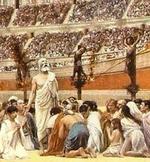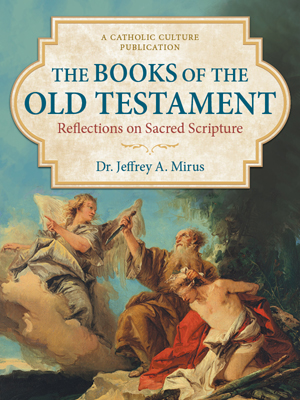On the Earthquake
By Dr. Jeff Mirus ( bio - articles - email ) | Aug 24, 2011
In Tuesday’s Insights message, I mentioned the great Washington, DC earthquake of 2011. Washington was not at the center, of course; that was in Mineral, Virginia, a town of fewer than 500 people some sixty miles southwest of the nation’s capital as the crow flies—roughly midway between Fredericksburg and Charlottesville. Still those who experienced the quake in the Pentagon said that it reminded them way too much of the terrorist attack of September 11, 2001.
My wife and I were sitting in a restaurant in Centreville, Virginia enjoying a rare late lunch with some old friends when the earthquake hit yesterday at 1:53 pm. Yes, I know I should have been at the office working, but who wants to work during an earthquake? Anyway, the last time our friends had been to a restaurant, a jeep had plowed through the front windows and rolled to a stop not far from their table. So naturally, if we expected anything to happen, we wanted to be with Carol and Gerry.
Not being clairvoyant, in fact we didn’t expect anything to happen. But when the whole building started shaking—and this went on for perhaps thirty seconds or so—Carol was looking wildly around to see if a Mack truck was thundering into the kitchen, and I felt confused, as if I were suddenly in Chicago and an elevated train was speeding by right next to the dining room. About halfway through the shaking and shuddering, we all realized it had to be an earthquake. We’re Easterners; we had never felt one before.
The culprits, apparently, are the infamous Spotsylvania and Lakeside faults, which run parallel to the Appalachians. This quake, caused by one rock mass sliding up and over another, occurred relatively close to the earth’s surface, a little less than four miles down, hence causing quite a bit of topside shuddering.
The result is some new cracks at the top of the Washington Monument, and the National Cathedral (Episcopalian) also lost three of four spires on the main tower, as well as experiencing significant cracks in some of the flying buttresses. Some schools in Montgomery County, Maryland were damaged. In Mineral, some residents watched their possessions fall as interior shelving cracked and, running outside, at least one saw his chimney tumble. But overall property damage was relatively slight, and thankfully no loss of life or serious injury has been reported. Washington’s afternoon rush hour, now officially the worst in the nation, started very early yesterday, as workers were sent home pending building inspections.
Frankly, I have always thought the middle of the Eastern Seaboard in the United States was one of the safest places to live. We just don’t have natural disasters, despite the fact that it is now popular to warn of tornados every time a significant thunderstorm develops. You get that kind of thing with some frequency in the coastal plain, but back in the piedmont (where I live and work) we learn to expect that nature is not going to challenge us all that much.
Northern Virginia is much like Washington, DC in this respect: We don’t have that many problems thrust upon us by God, so we get cocky and make our own. We don’t have to pray too hard to be protected from the forces of nature. But in these parts we know how to make up for that. I’m just sayin’.
As earthquakes go, this one just missed the “strong” category, with Richter Scale readings of 5.8 or 5.9. The first aftershock was about 2.8, and there have been three others, one 4.8, but extremely brief. Some news people were reporting that the first aftershock was just a little less than half the strength of the original. But, as we say in Mineral, Virginia, “Not hardly.” Gerry tried to explain that the Richter scale is geometric, not arithmetic, but he has an exceedingly flexible mind and it won’t bother him at all to think in terms of a base-10 logarithm instead, based on the amplitude of the motion waves of the quake. Look, the reason I invented the Internet was so I could look smart: Each full unit on the Scale represents a 10-fold change. So three units up on the Richter Scale represents an increase in intensity of 10 times 10 times 10, or 1,000 times. Put another way, the force of the first aftershock was one one-thousandth of the original. Even our most sensitive politicians didn’t feel that pain.
My sister at Lake Monticello (a mere 30 miles from the epicenter) experienced a crack or two in the drywall in the garage. Several of my kids called or emailed to trade stories. Peter first thought a helicopter was landing on his roof. Katherine and Mara, in separate households, initially thought their active pre-school boys were upstairs and completely out of hand. One of my brothers-in-law called from New England and asked what the heck we were doing having an earthquake in Virginia. And that, in the end, is what I’m here to tell you.
Most of us, at least, were having an earthquake in Virginia to remind ourselves, however fleetingly, that we are not ultimately in charge of anything, including our own lives. Earthquakes, in this sense, are good therapy. An earthquake near the most powerful city in the world is even better therapy. So I suppose that’s all there is to it, really. We can’t control earthquakes, but perhaps there is someone who can. It’s a shot across the bow, anyway. Think about it.
All comments are moderated. To lighten our editing burden, only current donors are allowed to Sound Off. If you are a current donor, log in to see the comment form; otherwise please support our work, and Sound Off!








